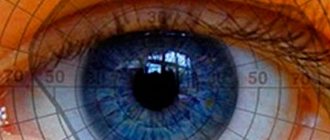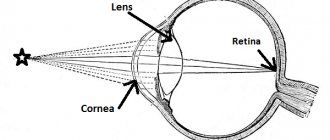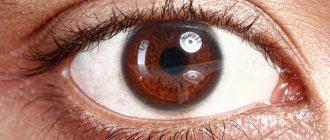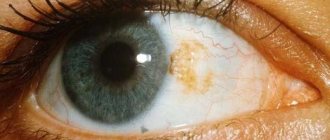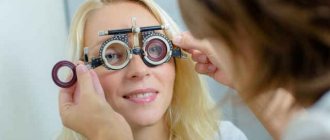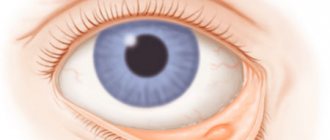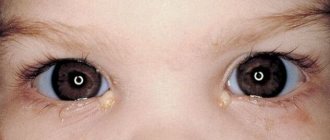- Treatment Conclusions
Defects in the optical path distort the perception of the surrounding world and are accompanied by various everyday and work problems. In the worst situations, health-threatening diseases arise. To eliminate deficiencies, glasses and contact lenses, therapeutic treatment and surgery are used.
If a person has negative vision, is it nearsightedness or farsightedness? How to choose the right glasses? What determines the effectiveness of preventive measures? What is good for vision? Answers to these and other thematic questions are presented in this publication.
What is myopia (nearsightedness)
A disease in which it is difficult for a person to see distant objects, but at the same time he sees well at a short distance, is called myopia. People simply call it myopia.
Due to changes in the shape of the eyeball, any image is focused in front of the retina, and not, as normal, on it. In order for a person to see an object, he has to bring it closer. It happens that myopia affects one eye or both.
People with such vision are often asked how exactly their disease manifests itself and what is meant by myopia. They answer that myopia is when you have trouble seeing into the distance, but reading a book or doing any work at a short distance from your eyes is not difficult.
There are several reasons that provide a trigger for the development of myopia:
- Heredity is the main factor that influences the occurrence of myopia. Even if one of the parents has myopia, the child has a significantly increased risk of acquiring this disease.
- Heavy workloads among students also affect their vision. That is why the disease often manifests itself between the ages of 7 and 20 years. During this period, the strain on the eyes is maximum, because it is necessary to devote time to doing homework or being at the computer. Vision may remain the same or gradually deteriorate.
- Incorrectly selected glasses or lenses can reduce the quality of vision. It is important that the doctor selects glasses taking into account all the features and only after a thorough examination. It is also worth remembering all the rules for wearing glasses and checking your vision regularly in order not to trigger the condition.
- If your profession requires you to work with objects at a short distance, this can impair your vision. For example, this is the work of laboratory technicians, watchmakers, and jewelers.
- The habit of reading while lying down or sitting in public transport, watching TV for a long time, spending time at the computer - this is something for which it is not for nothing that their parents scold their children. These bad habits lead to myopia.
- Reduced immunity in people with insufficient quality nutrition, which is not rich in vitamins and microelements, is also a risk factor.
Types of myopia
Ophthalmologists divide myopia into the following types :
- Congenital myopia. This form is rare and is diagnosed from birth, due to abnormalities in the development of the eyeball.
- High. The degree of such myopia exceeds 6.25 diopters.
- Combination. Low degree myopia, in which the combination of the power of the optical system of the eye in the refracted state and the length of its axis does not provide normal refraction.
- Spasmodic (false). It occurs when the tone of the ciliary muscle increases and disappears when the tone returns to normal.
- Transitional. A type of false myopia that occurs with the development of other diseases of the body or as a result of the action of medications.
- Night. This type of myopia occurs when there is a lack of light.
- Axial. It appears when the optical axis of the eye is significantly long.
- Complicated. This myopia is accompanied by anatomical changes in the eye that lead to loss of vision.
- Progressive. It is characterized by a gradual increase in the defect as a result of stretching of the posterior ocular region.
- Refractive. Caused by excessive refractive power of the optical eye system.
Treating myopia with eye exercises for myopia. Exercise groups
Read about the treatment of chalazion with hydrocortisone ointment here
Is myopia a minus or a plus?
Healthy people or those who have recently encountered the problem of poor vision often do not understand whether myopia is a minus or a plus?
Glasses or lenses that need to be purchased for myopia should only have a minus sign. Glasses are made using concave lenses, contact lenses also need to be selected in the appropriate shape.
With age, the disease can progress and move from low to moderate, etc. That's why it's so important to visit your doctor regularly and have your vision checked - you may need to change your contact lenses or glasses to stronger ones.
Wearing vision devices in childhood can improve or even restore vision. In old age, people buy glasses for temporary wear so as not to experience discomfort when communicating with people and performing everyday activities.
It is important to understand what it is - myopia and farsightedness, and determine the condition of your eyes with the help of a doctor.
Features of myopia
To make it more clear, we need to consider the structure of the eye with myopia. Thus, with the mutual functionality of the lens and cornea, rays are transmitted that transmit the image. These two elements of the eye refract to create clarity. After refraction, the beam reaches the retina, which perceives the image. These focuses are then converted into a nerve impulse and sent along the optic nerve to the brain. This is how any visual information is transmitted.
With myopia, everything happens differently. The fact is that the rays begin to refract before they reach the retina. Why is this happening? In fact, with myopia, the eye organ lengthens slightly, and therefore moves away from its usual and normal focus. For example, a healthy eye has a size of 23-24 mm, and with myopia it is as much as 30 mm. For visual perception, you can look at the photo:
Symptoms and degrees of myopia (myopia)
To find out about myopia, what it is and what the symptoms of this disease are, the main complaints of patients are collected:
- Bluriness of objects located far from a person.
- Floaters before the eyes, sensitivity to light.
- It is difficult to shift your gaze from a near object to a distant one.
- Fatigue is increased, especially after work that requires high visual attention.
- Irritability, headaches. At school age, children's academic performance declines.
- Color identification is difficult.
Ophthalmologists divide myopia into three degrees:
- Weak. The patient himself may not even notice a significant deterioration in his vision and does not consult a doctor. Vision deviates from normal by only 1-3 diopters. Many mothers of schoolchildren know what it is - 1st degree myopia, because this is where it all begins.
- Medium – more pronounced, can negatively affect the quality of work and reduce productivity. Vision deteriorates from 3 to 6 diopters. To understand what grade 2 myopia is, it’s enough to imagine that a person with such vision can see objects located no further than 25 cm.
- Strong. Indicators for this condition start from 6 diopters. In the most difficult cases, the patient may not be able to distinguish objects in the distance at all.
Lens selection
There are three degrees of development of myopia, as well as three degrees of farsightedness. The classification in this case is as follows.
Degrees of myopia:
- weak: up to -3 D;
- medium: -3 to -6 D;
- high: from -6 D.
Degrees of hypermetropia:
- weak: up to +3 D;
- medium: from +3 to +6 D;
- high: from +6 D.
Corrective lenses are selected depending on the extent to which vision is impaired. Moreover, for myopia and farsightedness they differ both in shape and appearance. This is typical for both glasses and contact lenses.
For myopia, biconcave lenses with negative optical power are used. Such lenses are called diverging and are designated in ophthalmology with a minus sign.
For hypermetropia, biconvex lenses with positive optical power are used. They are called collecting and are marked in ophthalmological practice with a plus sign.
Lens types
Note: if you wear glasses for myopia, then when looking through the glass, objects will visually shrink, but if you wear glasses for farsightedness, they will increase in size.
To correct vision for myopia or hyperopia, spherical contact lenses are used, and for presbyopia (age-related farsightedness) - multifocal, including bifocal.
False myopia or spasm of accommodation
Accommodation spasm is a vision pathology in which visual acuity at distance and near decreases, pain in the eyes and fatigue appear.
But it is called false myopia because this process is reversible. It is enough to use eye drops that dilate the pupil.
This condition is often observed in children, but sometimes occurs in adults. It occurs due to increased strain on the eyes due to prolonged work at the computer, reading, schoolwork, and working with small objects.
A change occurs in the eye muscle, causing the person to be unable to see objects at any distance. This condition is temporary, but can recur under heavy loads.
In addition to decreased vision, a person experiences pain in the frontal and temporal region; when there is strain on the eyes, he quickly gets tired and loses the ability to see equally with his eyes.
These symptoms cannot be called specific, so if they appear, you should immediately consult an ophthalmologist.
Prevention of myopia
The progression of the disease can be stopped by adhering to the following simple rules:
Maintaining the correct regime for visual work
In the process of prolonged visual work, tension increases and blink frequency decreases. As a result, the surface of the cornea dries out, and the tear film is renewed much less frequently. This causes burning in the eyes, stinging, dryness and discomfort - the initial signs of dry eye. Prolonged tension in the visual organ leads to a slowdown or stagnation of metabolic processes in the structure of the eye, as a result of which myopia develops.
Maintaining proper lighting
One of the main conditions that is necessary for normal visual work is good and proper lighting. The light in the workplace should not be too bright and dazzling, but it should provide good visibility. The light should fall on the workplace from the left side.
Maintaining the correct posture when reading
You cannot read in a lying position , or in a moving vehicle . When reading, your back should be straight, the distance from your eyes to a book or magazine should be 30–40 centimeters .
Periodic use of visual gymnastics
Visual exercises help relieve eye strain and eliminate dryness of the visual organ. Sample exercises:
- Look at the tip of your nose, then move your gaze. Repeat 5 - 6 times.
- Hold your gaze on your index finger at a distance of 25–30 centimeters, then move your finger to the tip of your nose and look into the distance. Repeat 5 – 6 times.
- Close your eyes tightly, open them and look into the distance.
- Blink a little and then close your eyes for 5 seconds. During this exercise, you need to keep your head straight.
- Look out the window at a very distant object and examine it for 10 seconds, then move your gaze to any close point or to your palm. Repeat 5 – 6 times.
Also, general strengthening of the body, exercise, proper nutrition and private walks in the fresh air will also benefit the eyes.
Albucid drops instructions. Use for various diseases
All about the symptoms and causes of demodicosis of the eyelids here
For instructions for Vizin Pure Tear eye drops, see this link https://eyesmaster.ru/lechenie/glaznye-kapli/vizin-instruktsiya-po-primeneniyu.html
Differences between myopia and farsightedness
To understand when vision is negative - it is farsightedness or nearsightedness, you should clearly separate the boundaries of these two diseases. When farsightedness develops, a person has no problems seeing an object in the background, but he cannot perform work near the eyes.
This is the main difference between the two vision pathologies. For a person with myopia, only glasses with a “-” sign are suitable. And if you are farsighted, you need to purchase vision devices with a plus sign.
With myopia, light rays are focused in front of the retina, causing distant objects to blur before the eyes. Concave lenses cause light rays to diverge, correcting the image.
And with farsightedness, light rays are focused behind the retina - while the muscles that are responsible for focusing the lens are relaxed. Nearby objects blur when you look at them.
Thanks to the listed symptoms, it becomes clear if the plus vision is farsightedness or nearsightedness. Therefore, the initial diagnosis can be done independently, simply by observing the difference in the image of objects in front of you and in the distance.
Causes of visual impairment
With myopia, light rays entering the eye are refracted in such a way in transparent media that the images are focused in front of the retina. The reason for this is the structural features of the cornea and lens of the eye, as well as its elongated anterior-posterior axis.
To correct myopia, minus lenses are selected. The refractive power of such lenses depends on the degree of myopia:
- Up to -3D – weak degree,
- From -3D to -6D – average degree,
- Above -6D is a high degree.
Complications of myopia
The risk of various complications increases along with the progression of the disease. People with a high degree of myopia are most susceptible to complications.
The following complications are possible:
- Retinal disinsertion. One of the most dangerous complications of myopia. The main symptom is the appearance of a veil before the eyes. The patient complains of cloudiness, which gradually covers the entire space in front of the eye. Often in myopic people this symptom appears suddenly. It is not painful, but flashes, lightning, or sparks may appear in the eyes.
- Degenerative processes. For example, clouding of the lens, etc.
- The appearance of Fuchs' spot - it appears as a result of hemorrhage in the macula. This sign means the appearance of ruptures in newly formed vessels that have an irregular structure. Light-sensitive cells are destroyed.
- Dystrophic changes in the retina - lattice dystrophy, etc.
To prevent such conditions, it is important not to neglect your vision and regularly visit a doctor. Eye exercises will help strengthen your eye muscles and nerves.
Timely use of drops prescribed by a doctor will help stop the deterioration of vision. There are entire complexes of vitamins that are aimed at enhancing the quality of vision. It is necessary to reduce eye strain and allow yourself breaks from work or study.
Now it becomes clear that myopia is a minus, and glasses should only be worn with this sign. They will have a positive effect and help restore or maintain visual acuity.
There are other methods of vision correction - medications, physical therapy, special exercises or surgery.
Thanks to the article, such a question as a minus will not arise - is it myopia or farsightedness? The difference is obvious, as is the fact that any of these conditions can be overcome for the sake of a clear vision of the world around us.
Author: Irina Levchenko, optometrist, especially for Okulist.pro
Treatment of myopia
This disease can be corrected in any case. This applies even to situations where a person almost completely loses the ability to distinguish nearby objects. The patient’s tasks include timely contacting a specialist and preventing the development of related diseases.
During this time, consult a specialist to avoid illnesses
The main ways to get rid of myopia, which are effective for every patient:
- Use of lenses and glasses. This allows not only to improve vision immediately after using the method, but also to stop the progression of pathology and gradually influence the processes of independent restoration of eye tissue.
- Refractive therapy, which consists of the constant use of night lenses.
- Correction of pathologies using laser beams.
- Renewal of the lens, that is, complete removal of the old one with the insertion of an artificial element.
- Placing special lenses inside the eye.
High degree of myopia
If a patient is told that his vision has fallen by more than 6 diopters, he is automatically classified as a group of people suffering from high myopia. Sometimes this value increases to 15 diopters. With this course of the disease, it is difficult to correct vision with light measures, since they do not give sufficient results. The laser cannot be used in case of strong deviations. Doctors use hard lens implantation for radical correction.
Implantation of hard lenses
Fighting myopia
Sometimes children suffer from myopia, and the deterioration of the eye condition occurs by no more than 0.5 diopters every year. This situation can be corrected using conservative methods, which is absolutely painless for the child; such treatment, when carried out correctly, evokes only positive emotions. It is necessary to perform the following procedures step by step:
- Step 1. Selecting lenses or glasses through consultation with a specialist. If a patient needs rare types of vision correction devices, he will have to make an individual order.
- Step 2. Exercises to develop and strengthen the eye nerves and muscles.
- Step 3. Use special drops, and they should be used in a timely manner.
- Step 4. Taking vitamin complexes, which contain the necessary substances to enhance vision in general.
- Step 5. Reduce eye strain, take timely breaks from work, study or intense games.
